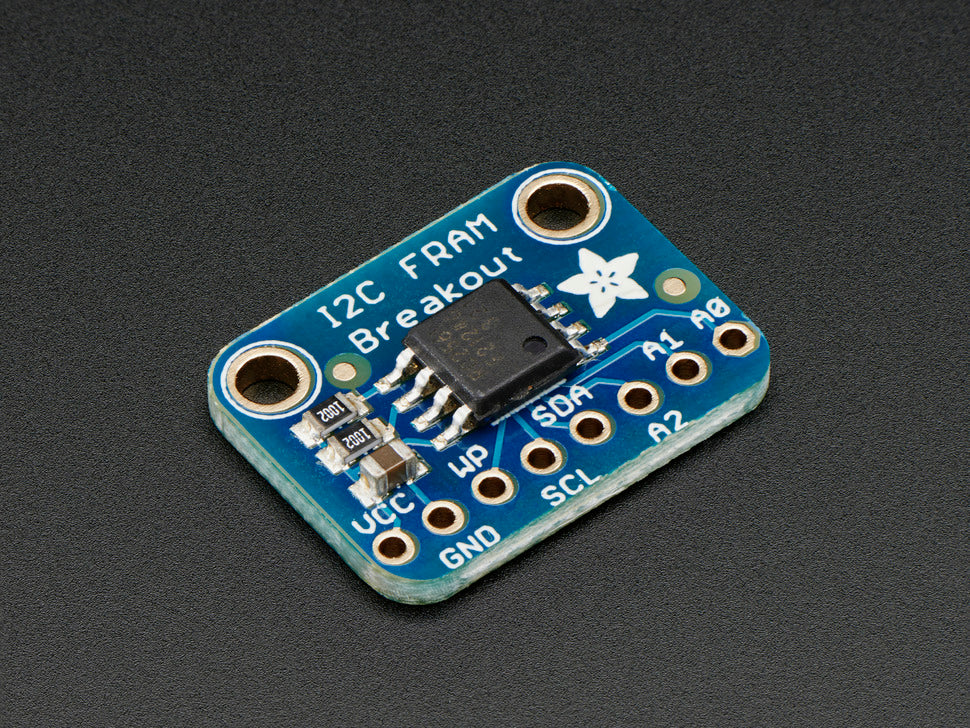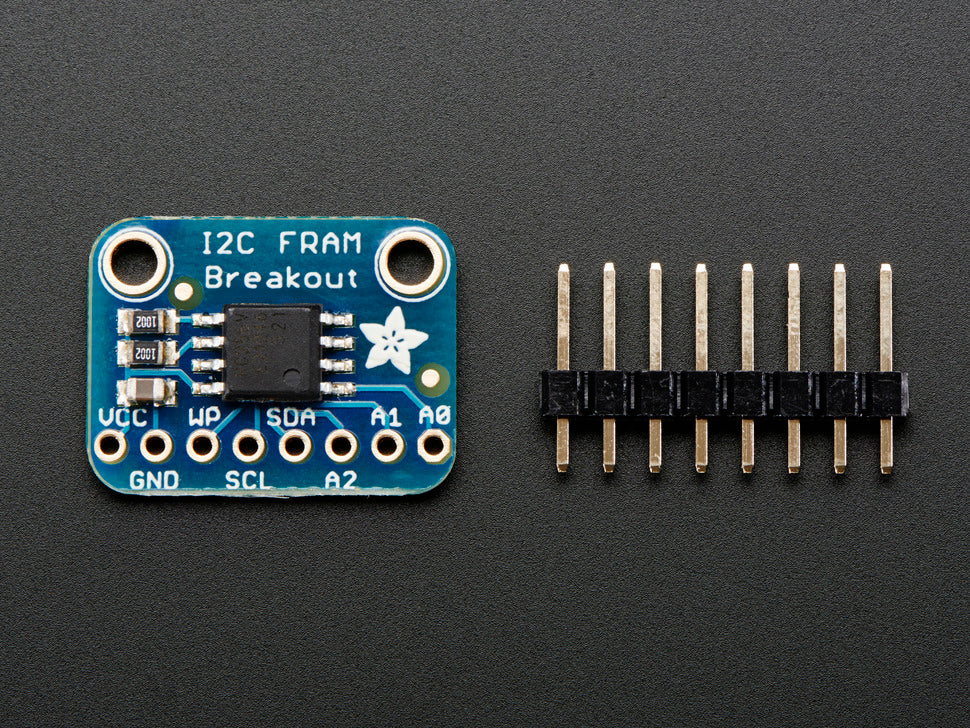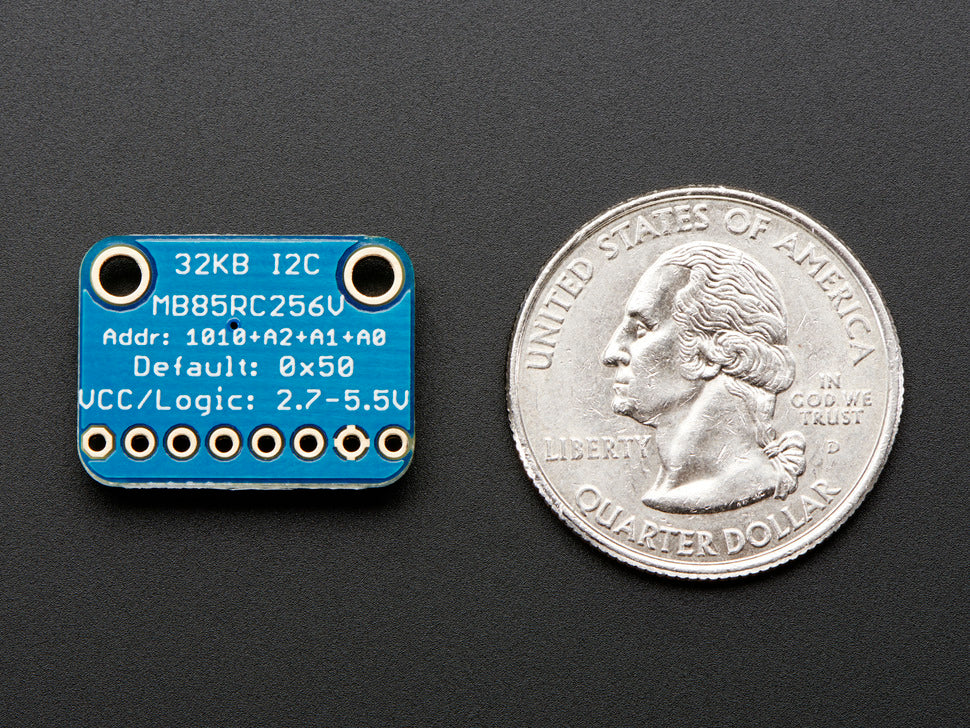BESCHREIBUNG
TECHNISCHE EINZELHEITEN
- Abmessungen: 15.5mm x 20mm x 2mm / 0.6" x 0.8" x 0.1"
- Gewicht: 1.2g
- Datenblätter, EagleCAD PCB-Dateien und Fritzing-Objekt im Tutorial verfügbar
DESCRIPTION
FRAM, or Ferroelectric Ram, is the coolest new data storage method that all the fashion magazines are talking about. Oh wait, no that's quilted handbags. But FRAM is pretty damn cool too! It's similar to Dynamic random-access memory, only with a ferroelectric layer instead of a dielectric layer. This gives it stable handling (the bytes you write are non-volatile) with dynamic responsiveness (you can write them very fast!)
Now, with I2C FRAM breakout board you can add some FRAM storage to your next DIY project. FRAM allows for a lower power usage and a faster write performance. It's excellent for low-power or inconsistent-power datalogging or data buffering where you want to stream data fast while also keeping the data when there's no power. Unlike Flash or EEPROM there's no pages to worry about. Each byte can be read/written 10,000,000,000,000 times so you don't have to worry too much about wear leveling.
This particular FRAM chip has 256 Kbits (32 KBytes) of storage, interfaces using I2C, and can run at up to 1MHz I2C rates. Each byte can be read and written instantaneously (like SRAM) but will keep the memory for 95 years at room temperature.
Adafruit picked up the largest chip that has I2C and is also 5V compliant. You can use this chip with either 3V or 5V power and logic. It comes in a breadboard-friendly breakout and a spare stick of 0.1" male header for soldering on.
TECHNICAL DETAILS
- Dimensions: 15.5mm x 20mm x 2mm / 0.6" x 0.8" x 0.1"
- Weight: 1.2g
- Datasheets, EagleCAD PCB files, and Fritzing object available in the tutorial
Sicherheitsangaben
- Lesen Sie die Bedienungsanleitung sorgfältig durch, bevor Sie das Produkt verwenden.
- Stellen Sie sicher, dass alle Montage- und Installationsanweisungen des Herstellers sorgfältig befolgt werden.
- Verwenden Sie das Produkt nur für den vorgesehenen Zweck.
- Die unsachgemäße Nutzung dieses Produkts kann zu schweren Verletzungen oder Sachschäden führen.
- Nicht für Kinder unter 10 Jahren geeignet.
- Bei unsachgemäßer Verwendung besteht eine Verletzungsgefahr.
- Dieses Produkt entspricht den geltenden Sicherheitsanforderungen der Europäischen Union.
- Dieses Produkt wurde gemäß der GPSR geprüft, die sicherstellt, dass alle relevanten Sicherheitsanforderungen für Konsumgüter eingehalten werden.
Nachverfolgbarkeitsinformationen
Jedes Produkt verfügt über eines oder mehrere der folgenden Merkmale:
- Ein CE-Kennzeichen, das die Einhaltung der Sicherheits-, Gesundheits- und Umweltschutzanforderungen der Europäischen Union anzeigt.
- Eine eindeutige Serien- oder Chargennummer, um die Nachverfolgbarkeit zu gewährleisten und bei Bedarf Rückrufaktionen zu unterstützen.
- Hersteller- und Importeurangaben für den Kundensupport und Sicherheitsanfragen.
Überwachung und Berichterstattung von Vorfällen
Für den unwahrscheinlichen Fall eines Produktproblems haben wir Verfahren implementiert, um:
- Kundenbeschwerden zeitnah bearbeiten.
- Schwerwiegende Vorfälle über das EU Safety Gate/RAPEX-System melden.
- Mit den Marktüberwachungsbehörden zusammenarbeiten, um die öffentliche Sicherheit zu gewährleisten.
Kontakt:
- Email: support [@] pi3g.com
- Telefon: 0341 / 392 858 40
Dieses Produkt ist vollständig mit allen geltenden EU-Vorschriften konform, um die Sicherheit unserer geschätzten Kunden zu gewährleisten.



